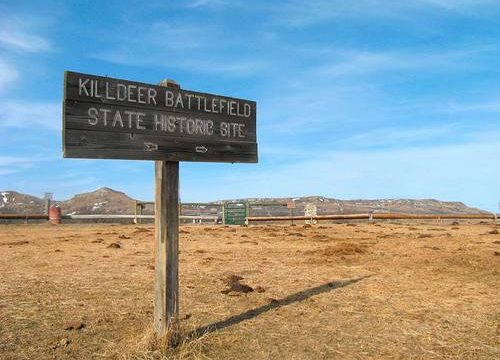Did A NDSU Professor Use A Federal Grant To Try And Roadblock Western ND Power Infrastructure?

There is a lot riding on the transmission line project which would, if approved, run through the Killdeer Mountain area, including the site of a historic battle between the US Army and Sioux Indians. A Montana state official warned recently that if the lines are held up, the Bakken region (facing surging population growth and demand for electricity) could face brownouts. Last year North Dakota saw a spike in the percentage of natural gas flared because a gas plant in the western part of the state went down when a storm knocked out some of the fragile power infrastructure.
Rep. Kevin Cramer recently pointed out while questioning EPA officials that North Dakota has a looming power shortage problem that’s driven by growing demand for electricity in the west.
So the transmission lines are important, but the project has faced heavy opposition from those who think it would infringe on the battlefield area. One of the opponents is a North Dakota State University professor who, shortly before a recent Public Service Commission hearing on the transmission lines, presented a federal study that would seek to declare the battlefield a federal historic site, derailing the transmission lines.
But last night the Dunn County Commission rejected the study, and a local landowner who supports the project has contacted the FBI accusing the professor of fraud:
Dvirnak said every nearby landowner he’s talked to is also against the study. He also alleged that NDSU professor Tom Isern, who applied for a National Park Service grant to fund the study that could place some of the land on the National Register of Historic Places, didn’t correctly fill out the application he used to get federal funding in August for the study.
But Isern said in an interview that Dvirnak simply misunderstands what was required by the application, and misunderstands the extent of the study area.
“I’m afraid the Dvirnak brothers have been intentionally misrepresenting this study,” Isern said.
“My interpretation is we followed the guidelines of the National Park Service’s program and that’s why they funded the proposal.”
But Dvirnak said the grant application was supposed to include the names of all landowners in the project area and did not.
“I was born and raised here. I know everybody that is in this project area,” he said. “When I show this grant application to other neighbors or other landowners in this project area, they’re looking at this and they’re saying the same thing: ‘What is it with this guy?’”
According to the article, Dvirnak says an FBI inquiry into the application is on-going, though the FBI wouldn’t confirm or deny it.
If Isern left out some property owners, it’s a pretty big deal. A few years back former Democrat state Senator, and US Senate candidate, Tracy Potter was rebuked by the National Park Service for failing to get the proper amount of local buy-in for a federal National Heritage Area land designation. “The feasibility study produced by the Northern Plains Heritage Foundation [Potter’s group] did not meet all of the criteria for designation as a national heritage area. It did not include the existence of significant levels of public involvement and support and the local commitments necessary for successful planning and implementation of a heritage area,” Katherine Stevenson, an assistant director of the National Parks Service, said in testimony before Congress at the time.
Isern says his grant application was filled out correctly and that’s why the feds funded it. But it’s worth noting that the Northern Plains Heritage Area was also funded by Congress, despite lacking (at least in the eyes of the NPS) the appropriate level of local buy-in.
Regardless, the timing of Isern’s study and the fact that he clearly didn’t involve all of the impacted property owners makes it seem as though the study is less about study than roadblocking much needed energy infrastructure.




